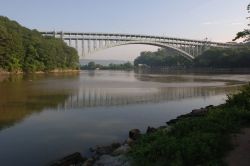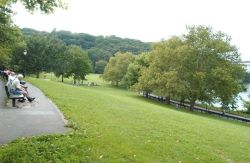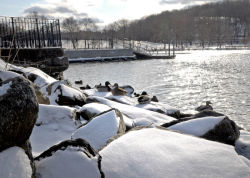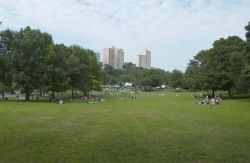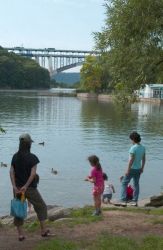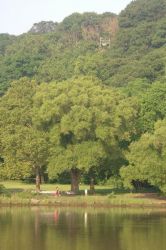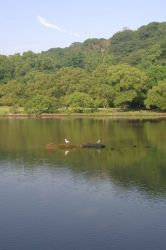Inwood Hill Park
Fort Cockhill
In the summer and fall of 1776, New York was the primary battlefield of the war for America's independence. At stake were the City's strategic harbor and inland waterways, especially the Hudson River. By controlling the Hudson Valley, the British hoped to prevent the armies of New England and the South from combining into a unified force.
Among the many forts built in New York by the Continental Army, three were located on the heights of northern Manhattan that overlook the Hudson River, allowing the army to direct their cannon fire at enemy ships below. The largest of the three was Fort Washington, which stood atop the highest point on Manhattan Island, at today's 184th Street. Situated to the north of Fort Washington were two of its outworks, Fort Tryon and Fort Cockhill.
Fort Cockhill stood on this hilltop, overlooking the mouth of Spuyten Duyvil Creek at its confluence with the Hudson. It was a small, five-sided earthen structure equipped with two cannons. On the morning of November 16, 1776, Fort Cockhill was attacked and captured by a battalion of Hessian (German) Grenadiers that served in the British Army. After taking Fort Cockhill, the Hessians hauled heavy guns and a howitzer to the top of the hill and fired on the American defenders at Fort Tryon. Fort Tryon was taken after heroic resistance by its greatly outnumbered defenders.
A short while later, the commander of Fort Washington, General Magaw, surrendered to attackers and the battle was over. The Americans were overwhelmed by the numerical superiority of the British-Hessian force and the effectiveness of their attack. It was a devastating defeat, in which the Patriots lost almost 3,000 troops, 2,800 of whom were taken as prisoners. Most of the captives died in prison as victims of deprivation and exposure.
In July of 1781, Washington and his generals surveyed the forts of northern Manhattan from nearby points in the Bronx, apparently preparing to attack New York again and to reclaim their captured forts. By that time Fort Cockhill showed signs of neglect, as reflected in Washington's observation that "the fort on Cox's Hill was in bad repair and but little dependence placed on it. There is neither ditch nor friezing, and the northeast corner appears quite easy of access." This attack never materialized, but the preparations for it served to divert British attention and resources away from the upcoming battle at Yorktown, Virginia, the deciding battle of the Revolutionary War.
While the British surrender at Yorktown on October 19, 1781 ended the active phase of the war, British military forces continued to occupy New York City until November 25, 1783. On that date, later known as Evacuation Day, General Washington was present to reclaim possession of the city he was forced to abandon in 1776. His reentry route from Inwood to the Battery took him past Forts Cockhill, Tryon and Washington, this time in triumph.
Check out your park's Vital Signs
Clean & Safe
Green & Resilient
Empowered & Engaged Users
Share your feedback or learn more about how this park is part of a
Vital Park System

Know Before You Go


